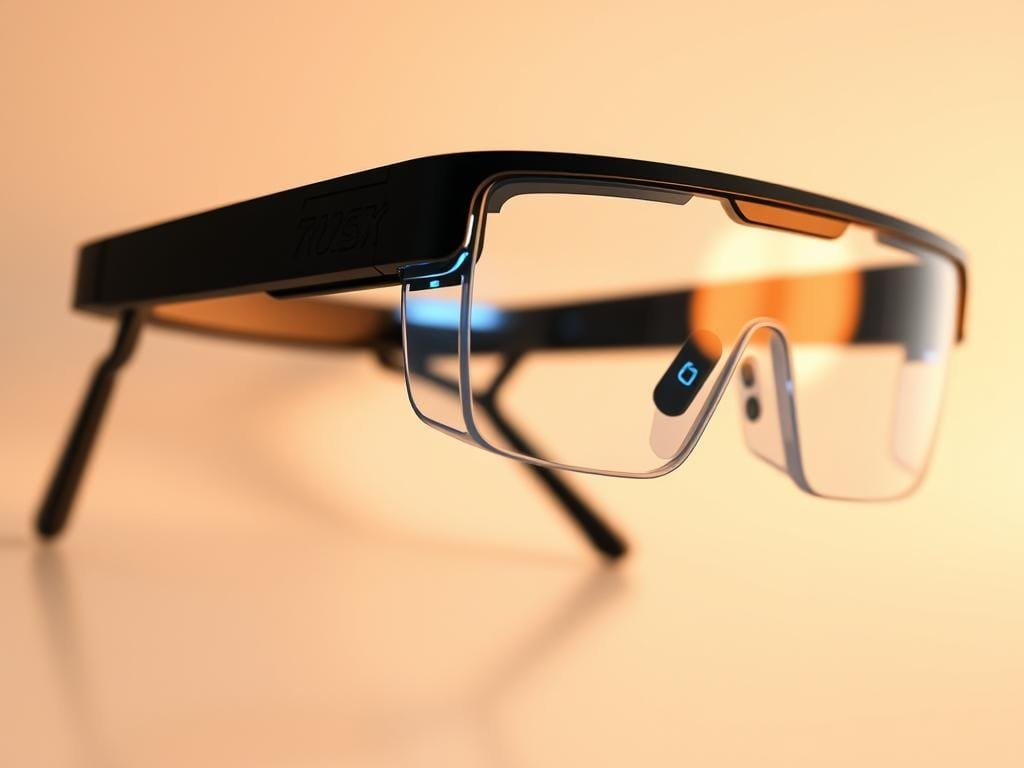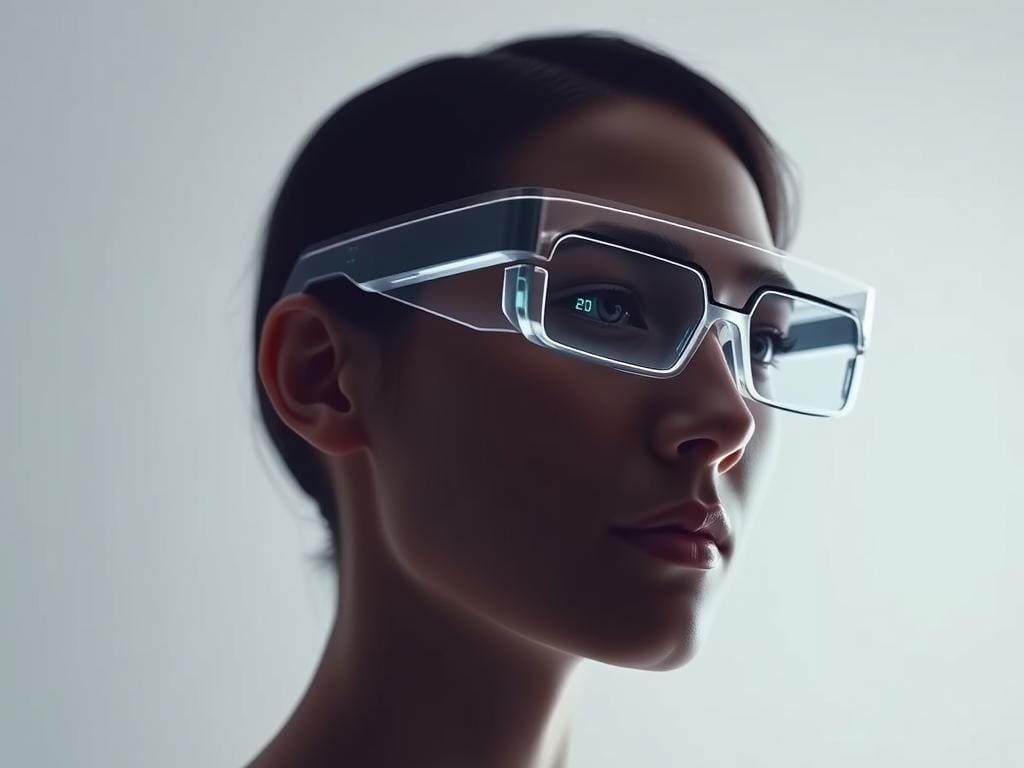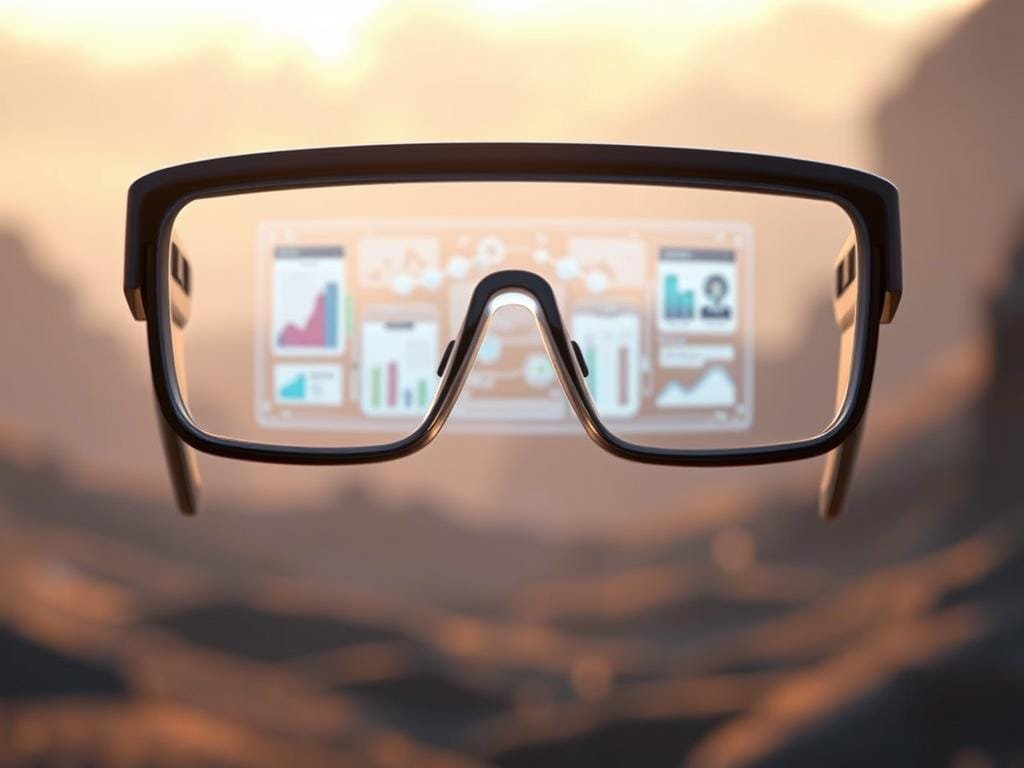Key Takeaways
- The development of AI-integrated wearables is on the rise.
- Companies like Meta, Google, and Apple are leading the charge.
- AI eyewear promises to revolutionize daily interactions.
- Potential applications include real-time information and enhanced communication.
- The future of wearables is shaping up to be exciting and innovative.
The Evolution of Smart Eyewear
Smart glasses have changed a lot, from the early days of Google Glass to today’s AI-driven models. It’s important to see how technology has improved this field.
From Google Glass to Today’s AI-Powered Options
Google Glass was the first try at smart glasses but faced privacy issues. Yet, it opened the door for better ideas. Now, AI-powered smart glasses are more common and advanced.
Today’s smart glasses can translate languages in real-time and show important info. They also respond to voice commands. These features make digital eyewear more interesting to many people.
Key Technological Breakthroughs
Several big tech steps have helped make smart glasses better. AI and machine learning now process data more accurately. Also, computer vision lets glasses understand their surroundings.
- Advances in AI and machine learning
- Improvements in computer vision
- Enhanced battery life and power management
- Development of more sophisticated display technologies
The Convergence of AI and Wearable Technology
AI and wearable tech coming together has been key for smart glasses. This mix makes devices more user-friendly and interactive. It also lets glasses be more personal and aware of their surroundings.
“The future of smart glasses lies in their ability to seamlessly integrate AI and wearable technology, creating a more natural and intuitive user experience.”
As smart glasses keep getting better, we’ll see more cool uses of AI and wearable tech. The possibilities for futuristic smart glasses to change many fields, like healthcare and entertainment, are endless and thrilling.
Understanding Smart Glasses AI Technology
Smart glasses AI technology is leading the way in wearable tech. It gives users a more interactive and intuitive experience. As AI grows, it’s changing how we use smart glasses.
How AI Powers Modern Smart Glasses
Artificial intelligence is key in today’s smart glasses. It brings features like real-time translation and hands-free control. AI uses machine learning algorithms and natural language processing to understand and act on user commands.
Core Components and Architecture
Smart glasses AI tech includes advanced processors, sensors, and displays. These parts work together for smooth interaction. The design supports real-time data processing for timely info.
To learn more about AI, check out A Beginner’s Guide to Artificial Intelligence. It offers a deeper look into AI’s role in tech.
The Role of Machine Learning in Smart Eyewear
Machine learning is vital in smart eyewear. It lets devices learn from users and adapt. This makes smart glasses more personal and easy to use over time.
AI and machine learning in smart glasses bring many benefits. They improve productivity and entertainment. As AI tech advances, we’ll see more cool uses in smart eyewear.
Major Players in the Smart Eyewear Market
The future of smart eyewear is being shaped by collaborations and innovative technologies. Several major tech companies are making significant strides in this space. They are pushing the boundaries of what’s possible with smart glasses.
Meta’s Ray-Ban and Oakley Collaborations
Meta has been at the forefront of smart eyewear innovation. They have partnered with renowned brands like Ray-Ban and Oakley. This has resulted in stylish and functional smart glasses.
For instance, Meta’s Ray-Ban Stories smart glasses offer a seamless blend of style and technology. They feature cameras, speakers, and a sleek design. This appeals to a wide range of consumers.
Google’s Ongoing AR Initiatives
Google continues to invest heavily in augmented reality (AR) technology. Its Android XR platform is poised to revolutionize the smart eyewear landscape. Google aims to enhance user experiences and create new opportunities for developers.
“The AR technology has vast transformational possibilities. Google is committed to pushing these boundaries.”
Apple’s Rumored Entry into the Market
Apple is rumored to be developing its own smart glasses. They will leverage their expertise in hardware and software integration. While details remain scarce, industry insiders speculate that Apple’s entry could significantly impact the competitive landscape.
| Company | Product/Initiative | Key Features |
|---|---|---|
| Meta | Ray-Ban Stories | AI-powered, camera, speakers, stylish design |
| Android XR | AR capabilities, enhanced user experience | |
| Apple | Rumored Smart Glasses | Potential integration with Apple ecosystem, sleek design |
Other Notable Manufacturers
Beyond the major players, other companies are also making significant contributions. Brands like Vuzix and Epson are developing innovative products. These cater to various consumer needs, from enterprise applications to personal entertainment.
As the smart eyewear market continues to evolve, we can expect to see even more exciting developments. These will come from these and other players, driving innovation and adoption.
Key Features of Modern Smart Glasses AI
Modern smart glasses change how we get information. They offer real-time translation and show contextual info. These AI-powered devices aim to simplify your life.

Real-Time Translation Capabilities
One standout feature is real-time translation. It lets you talk to people who speak different languages. This makes traveling more fun and easy.
Thanks to AI, these glasses translate languages instantly. This gives you a deeper experience when exploring new cultures.
Contextual Information Display
Smart glasses also show contextual information about your surroundings. This includes info on landmarks, restaurants, and more.
They help you get around better and find new places. This makes daily life more exciting.
Voice Command and Control Systems
Another great feature is voice command and control systems. It lets you use the glasses without your hands. This is super handy when you’re on the move.
With voice commands, you can do lots of things. Like call someone, send a message, or find info. All without touching the glasses.
Visual Recognition and Processing
The visual recognition capabilities of smart glasses are impressive. They use AI to identify objects, people, and places. This gives you useful insights.
This feature is useful in many ways. It can improve your shopping or help in work situations.
Practical Applications of Smart Glasses in Daily Life
Smart glasses are becoming a big part of our daily lives. They are not just a fun gadget. They help us in many ways, making our lives easier and more fun.
Navigation and Travel Assistance
Smart glasses are great for getting around. They use GPS and AR technology to show you where to go. This is super helpful for travelers, letting them explore new places without looking at their phones all the time.
Professional and Workplace Uses
At work, smart glasses can really boost your productivity. They let you talk hands-free, so you can keep working without interruptions. They also give you real-time data, helping you do your job better in fields like logistics and healthcare.
Entertainment and Social Media Integration
Smart glasses also change how we enjoy entertainment and connect on social media. You can play AR games or watch virtual concerts right through your glasses. Plus, you can take photos and videos without using your hands, making it easy to share your life online.
Health Monitoring and Fitness Tracking
Smart glasses are also great for keeping an eye on your health. They have sensors that track your vital signs and your workouts. This is perfect for anyone who loves to stay active or wants to keep a close eye on their health.
In short, smart glasses are not just a cool idea. They are a real tool that can make a big difference in our lives. They help us navigate, work better, have fun, and stay healthy. They are changing how we live, work, and play.
How to Choose the Right Smart Glasses for Your Needs
Choosing the right smart glasses with AI technology is easier when you focus on a few key things. Look at compatibility, battery life, and style. It’s important to think about how you’ll use them to make sure they fit your needs.
Assessing Your Primary Use Cases
First, decide how you want to use your smart glasses. Do you need them for navigation assistance or professional applications? Knowing this will help you find the right features.
- Think about if you need real-time translation or contextual information display.
- Consider if voice command and control systems are important for you.
- Decide if you need visual recognition and processing capabilities.
Compatibility with Your Existing Devices
Make sure the smart glasses work with your devices, like your smartphone or tablet. Check if they use an OS that works well with your tech.

Battery Life and Charging Considerations
Battery life is key if you’ll use your smart glasses all day. Look for ones with a battery that lasts long enough for you. Also, think about how they charge – some offer wireless charging for ease.
Style and Comfort Factors
Smart glasses are something you wear, so style and comfort matter a lot. Think about the design and if it fits your daily life. Some are made to be stylish and discreet, while others focus more on function.
“The best smart glasses are those that seamlessly integrate technology into your daily life without being obtrusive.” – Tech Reviewer
By looking at these factors, you can pick the perfect smart glasses technology for you.
Step-by-Step Guide to Setting Up Your Smart Glasses
Setting up your smart glasses is the first step to a world of AI convenience. Follow this guide for a smooth experience.
Initial Configuration Process
The initial setup is key for your smart glasses. Start by charging and turning them on. Most come with an app that helps you set them up.
- Download and install the companion app from your device’s app store.
- Follow the in-app instructions to pair your smart glasses with your smartphone.
- Configure your language preferences and other basic settings.
You’ll agree to terms and possibly update your device’s software during setup.
Connecting to Your Smartphone and Other Devices
Connecting your smart glasses to your smartphone is vital. It lets you access features like notifications and data syncing.
- Ensure Bluetooth is enabled on your smartphone.
- Put your smart glasses in pairing mode as per the user manual.
- Select your smart glasses from the list of available devices on your smartphone.
For connecting to laptops or tablets, check your user manual for instructions.
Customizing Settings for Optimal Performance
To get the most from your smart glasses, customize settings to your liking.
- Adjust the display brightness and timeout settings.
- Configure voice command sensitivity and gesture controls.
- Customize notification preferences to filter out unnecessary alerts.
Try different settings to find what works best for you.
Troubleshooting Common Setup Issues
Setup issues are common. Here are solutions for some problems:
- Pairing Issues: Restart both your smart glasses and smartphone, and try pairing again.
- Software Updates: Make sure your smart glasses and app are updated.
- Connectivity Problems: Check Bluetooth is on and devices are close.
If problems continue, check the manual or contact support.
Mastering Smart Glasses AI Features
Learning how to use the AI in your smart glasses can really improve your experience. To get the most out of your ai-powered smart eyewear, you need to know its AI features.
Voice Command Tutorials
Voice command is a key feature of smart glasses. Start by learning the voice command system through the tutorial in your device’s settings. Here are some basic voice commands to try:
- “Take a photo” to capture an image.
- “Send a message” to compose and send a message.
- “Navigate to [location]” to get directions.
Gesture Control Techniques
Gesture control is another easy way to use your smart glasses. Learn gestures like tapping, swiping, and scrolling to move through menus. For example, a simple tap can select an item, or swipe left/right to switch views.
Optimizing Visual Display Settings
The display is key to your smart glasses experience. To adjust display settings, go to the display options in your device’s settings. Here, you can tweak brightness, contrast, and color balance to your liking. For tips on display settings, check out this article on ambient computing.
Battery Conservation Strategies
To keep your smart glasses’ battery going, try these tips:
- Turn off features you don’t need.
- Adjust the screen brightness to an optimal level.
- Use power-saving modes in your device’s settings.
By mastering these AI features, you’ll enjoy a smoother and more efficient experience with your smart glasses with ai technology. Whether for navigation, communication, or fun, knowing how to optimize their use will make a big difference.

Privacy and Ethical Considerations
The rise of AI-powered smart glasses raises important questions about privacy and ethics. As these devices become more common, it’s vital to address privacy concerns and societal norms.
Data Collection and Storage Practices
Smart glasses can collect a lot of personal data, like what you see, where you are, and how you interact with them. It’s important to keep this data safe and handle it responsibly. Manufacturers need to protect user privacy with strong data protection measures.
Key data collection practices to consider:
- Transparent data collection policies
- Secure data storage solutions
- User consent mechanisms
- Data minimization strategies
Surveillance and Recording Concerns
Smart glasses can record video and audio, raising concerns about surveillance and privacy. It’s important to have clear rules and regulations for their use in public and private spaces.
Potential solutions include:
- Implementing recording indicators (e.g., LED lights)
- Developing etiquette guidelines for users
- Creating privacy-preserving technologies
Regulatory Landscape and Compliance
The rules for smart glasses are changing, with different places having their own laws. It’s important for manufacturers and users to stay updated and follow these laws.
| Region | Regulatory Focus | Key Requirements |
|---|---|---|
| United States | Data privacy, surveillance | Compliance with state-level privacy laws |
| European Union | GDPR compliance, user consent | Transparent data handling practices |
| Asia-Pacific | Varying regulations by country | Adherence to local data protection laws |
Balancing Innovation with Privacy Protection
As smart glasses evolve, finding a balance between innovation and privacy is key. This means using technical solutions and promoting responsible use among users.
For more insights on AI technologies, including their ethics, visit Digital Vista Online to explore related topics.
Smart Glasses vs. Smartphones: A Comparative Analysis
The rise of AI-powered smart glasses has led to a comparison with smartphones. This comparison raises questions about their relative merits. It’s important to look at their functionality, user experience, and how well they integrate with other devices.
Functionality Overlap and Unique Capabilities
Smart glasses and smartphones share some features, like showing notifications and using voice commands. But smart glasses have unique features like hands-free interaction and augmented reality. For example, AI-powered smart glasses can translate languages in real-time and help with navigation.
Smartphones, on the other hand, have a wider range of apps, more storage, and better cameras. They are more versatile. But smart glasses offer a more convenient way to access information without needing to hold a device.

User Experience Differences
Using smart glasses and smartphones is different. Smart glasses are more discreet and hands-free. But they have smaller displays and lower resolution.
Smartphones offer a more immersive experience with bigger screens and better quality. But they need physical interaction, which can be a hassle in some situations.
Integration with Smartphones
Smart glasses are more likely to complement smartphones than replace them. Many smart glasses work with smartphones to enhance their functionality. This makes for a smoother user experience.
Smart glasses’ strength is in providing contextual information and hands-free interaction. This makes them a great addition to the smartphone ecosystem.
Cost-Benefit Analysis for Consumers
When thinking about smart glasses and smartphones, consumers should weigh their pros and cons. Smart glasses offer unique features but are a new technology. Smartphones are established with more apps and capabilities.
Consumers should think about their specific needs and preferences. This will help them decide between smart glasses and smartphones.
Future Developments in Smart Eyewear Technology
AI and machine learning are changing smart eyewear. We’re seeing big changes coming. These changes will shape the future of the industry.
Advancements in Display Technology
Display technology is getting a big boost. Soon, smart eyewear will have better displays. They might use Micro-LED or OLED for clearer images.
These upgrades will make smart eyewear better for daily use and special tasks. It will look and work better.
Integration with Emerging Technologies
Smart eyewear will also work with new tech. For example, it could use AI and machine learning for better health tracking or navigation. Working with 5G networks will make data transfer faster.
Industry Predictions and Roadmaps
Industry leaders are sharing their plans for smart eyewear. They talk about smoother device interactions, longer battery life, and better privacy. We’ll see more personalized experiences soon.
The future of smart eyewear looks bright. Keeping up with these changes will help you enjoy the latest tech.
Conclusion: Will Smart Glasses Replace Smartphones?
Thinking about the future of personal tech, the link between smart glasses and smartphones gets more complicated. Smart glasses are getting smarter, with cool features like real-time translation and voice commands. They also show you important info right in your line of sight.
But will smart glasses take over from smartphones? Smart glasses are great for quick, hands-free info. Yet, smartphones give you a fuller, more interactive experience. It seems smart glasses will add to our tech lives, not replace them.
Smart glasses and smartphones have their own strengths. Glasses are perfect for fast, glance-based info. Smartphones, on the other hand, offer deeper interactions. As AI improves smart glasses, we’ll see even more cool uses.
In the end, smart glasses and smartphones will likely work together. Each will have its own role. Keeping up with the latest in AI-powered smart eyewear is key as we move forward.
FAQ
What are smart glasses with AI, and how do they work?
Smart glasses with AI are wearable devices that use artificial intelligence. They offer features like real-time translation and voice command. They work by processing data from cameras and sensors with machine learning algorithms.
What are the benefits of using smart glasses with AI?
Smart glasses with AI boost productivity and entertainment. They also help with health monitoring. They provide real-time information and assistance, making daily life easier.
Are smart glasses with AI compatible with my existing devices?
Many smart glasses with AI work with smartphones and tablets. But, always check the specs to ensure they match your devices.
How do I choose the right smart glasses for my needs?
First, think about how you’ll use them. Check if they work with your devices. Also, consider battery life, style, and comfort.
What are the possible privacy concerns with smart glasses?
Smart glasses can collect and store data. This raises concerns about surveillance and recording. It’s important to know how your data is handled.
Can smart glasses replace smartphones?
Smart glasses with AI are not a full replacement for smartphones. But, they can offer a more convenient, hands-free experience.
What are the future developments in smart eyewear technology?
Future smart eyewear will likely see advancements in AI and augmented reality. We can expect better features and performance across industries.
How do I set up and use my smart glasses?
Follow the manufacturer’s guide for setup and connection. Customize settings for the best experience.
What are the key features of modern smart glasses AI?
Modern smart glasses AI offer real-time translation and contextual info. They also have voice command and visual recognition. These are made possible by AI and machine learning.
Are there any notable manufacturers in the smart eyewear market?
Yes, Meta, Google, and Apple are leading in smart eyewear. Other companies also offer AI-powered glasses with various features.






